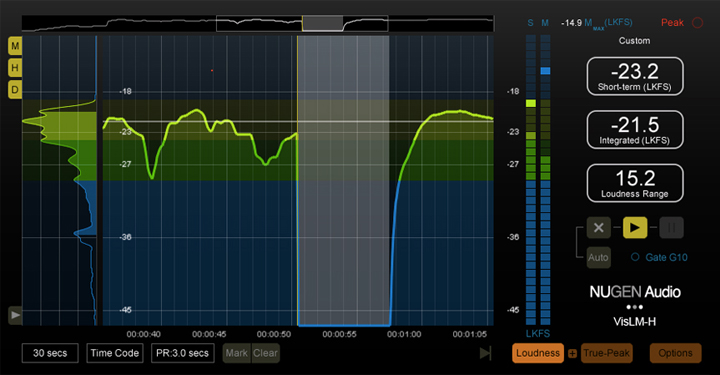On Tracks: What Is a Loudness Meter?
“Loudness” is the perception of audio level by humans.
Unlike the average level measured by VU meters or the peak levels measured by PPMs, such as the sample-peak meters in a typical digital audio workstation, loudness meters combine multiple types of measurements (including sound pressure level, frequency content and duration) using sophisticated algorithms to approximate perceived loudness and express it numerically.
Why is that important?
Essentially, it is to ensure that when you tune in a radio station or watch television, or even shuffle between music tracks on your player of choice, everything that you hear will be relatively similar in loudness so that you don’t have to constantly adjust a volume control to compensate.
In the case of radio and television, it is especially annoying when the commercials are dramatically louder than the other program material, and that concern provided the early impetus for the development of loudness standards that could be applied across the broadcast industry. And, at least in terms of radio, the relative loudness of the music being played was also a major consideration.
The Loudness War

Waves WLM Plus Loudness Meter
Due to the peculiarities of human hearing, when listening to two identical musical recordings at slightly different levels, the one that is louder will usually sound “better” to us. Similarly, two recordings with identical level readings on a standard meter can be perceived as being unequal in loudness. This is due to multiple factors, including those illustrated by the Fletcher-Munson Curves or “equal-loudness contours” (which will be the subject of a future On Tracks), but the salient point here is that louder generally sounds better to our ears.
This fact led record companies to attempt to make their releases sound better than those of their competitors by making them louder. Consequently, recording and mastering engineers were tasked with using every conceivable trick and technology at their disposal, especially compression and limiting, to make recordings blast forth from playback systems with ever-increasing levels of shock and awe. The situation got so bad that many recordings had practically zero dynamic range, and the audio was squashed so hard that the waveforms appeared as more-or-less solid rectangles.
Those recordings were definitely louder, but many of the qualities that make music sound good and enjoyable to listen to were casualties of the loudness war.
The Power of a Wider Dynamic Range
These days, consumer audio products, music streaming services, YouTube, and many other audio delivery systems, typically utilize some form of loudness compensation; and, ironically, recordings engineered for maximum blast often actually sound less powerful in comparison to those with wider dynamic ranges. Likewise with radio and other broadcasters, all of which have implemented the current loudness standards, at least in the U.S.
And what are those standards?
The International Telecommunication Union issued a Global Loudness Standard several years ago, the latest version of which, ITU-R BS.1770-3, was issued in 2012. There are additional standards derived from the ITU standard that apply in specific regions (e.g., ATSC A/85 in the U.S., TR-B32 in Japan, and EBU R128 in most of Europe), but they all specify measurements in LU or “Loudness Units.”
Loudness Meters

iZotope RX Loudness Control
Loudness meters provide measurements based on the ITU standard. They take into account the psychoacoustic considerations previously mentioned and are therefore much more accurate in determining the perceived loudness of a signal. The recommended, or in many cases legally required, average is -23LU.
The more technical expressions of loudness LUFS (Loudness Units relative to Full Scale), and LKSF (Loudness, K-weighted, relative to Full Scale), are equivalent terms used within different broadcast standards.
The feature sets of loudness meters vary, but they typically provide Short-Term, Long-Term, and Momentary loudness levels in either LUFS or LKSF, and True Peak level in dBTP (Decibels True Peak).
The bottom-line loudness value, however, is the Overall Program Loudness or Integrated Loudness or Loudness Range, depending on the meter. That’s the level that should be -23LU.
If you work with audio for radio, film, television, DVDs, video games and other post-production applications, loudness meters are essential to complying with the standards that apply to each.
But even if you are simply recording music for CD manufacturing or online distribution, loudness meters can be useful for zeroing in on optimal levels now that there is no longer any advantage to be had by participating in the loudness war.
This new column will address topics of interest to recordists, ranging from remedial tutorials on essential terms and concepts (such as this one) to more advanced examples of studio geekery. Next up in On Tracks: “What Type of EQ Should I Use and Why?”
FONTE: https://reverb.com/news/on-tracks-what-is-a-loudness-meter
Julian Ludwig é diretor do Pro Áudio Clube, produtora de áudio Jacarandá, Loc On Demand e Jacarandá Licensing. Trabalhou para empresas como: Guaraná Antartica, TV Gazeta, NET, Chivas Regal, FNAC, Prefeitura de São Paulo, Mukeca Filmes, Agência LEW’LARA TBWA, Agencia MPM, Agência Content House entre outras. Fez trilhas para programas de TV como: Internet-se (Rede TV), Você Bonita (TV Gazeta), Mix Mulher (TV Gazeta), Os Impedidos (TV Gazeta), Estação Pet (TV Gazeta), CQC (TV Band) Vinheta Oficial TV Gazeta, entre outras. Também atuou em vários longas e curtas metragens, incluindo mixagem em 5.1 e serviços de pós-produção.

